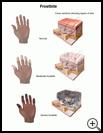
Frostbite
What is frostbite?
Frostbite is a skin injury where the nerves, blood vessels, and other cells are temporarily frozen by exposure to cold. Frostbite most commonly occurs on the toes, fingers, tip of the nose, earlobes, or cheeks. Frostbitten skin is cold, white, tingly, and/or numb.
The windchill temperature determines how quickly frostbite occurs. The frostbite is much worse if the skin or clothing is also wet at the time of cold exposure.
How can I take care of my child?
The main treatment for frostbite is to rewarm the area rapidly with wet heat. Place the frostbitten part in very warm water or cover it with warm wet cloths. The water should be very warm (104°F to 108°F, or 40°C to 42°C) but not hot enough to burn. Immersion in this warm water should continue until a pink flush signals the return of blood circulation to the frostbitten part (usually 20 to 30 minutes). At this point the numbness should disappear.
If your child has lots of frostbite, the last 10 minutes of rewarming are usually quite painful. If there is any pain, your child can take ibuprofen or acetaminophen. Offer warm fluids such as soup or hot chocolate to drink.
If your child is outdoors, try to get indoors as soon as possible. Start rewarming the frostbitten skin right away. If gloves or socks are wet, remove them. You can warm and thaw the frostbitten skin with one of these methods:
- Place hands under armpits or feet against a warm person's belly.
- Dry and cover the area with warm clothes and then layers of blankets.
Do not apply snow to the frostbitten area or massage it. Both can cause serious damage to thawing tissues. Do not rewarm the area with dry heat, such as a heat lamp or electric heater because frostbitten skin is easily burned.
How can I help prevent frostbite?
- Be sure your child dresses in layers for cold weather. The first layer should be thermal underwear, and the outer layer needs to be waterproof. The layers should be loose, not tight. Mittens are warmer than gloves.
- Your child should wear a hat. Over 50% of a child's body heat is lost from the head.
- Set limits on the time spent outdoors when the windchill temperature falls below 0°F (-18°C).
- Teach your child to recognize the earliest warnings of frostbite. Tell him that tingling and numbness are reminders that he is not dressed warmly enough for the weather and needs to go indoors.
When should I call my child's healthcare provider?
Call IMMEDIATELY if:
- A large area is frostbitten.
- The color of the skin and sensation don't return to normal after 1 hour of rewarming.
- Your child is acting confused or very sick.
Call during office hours if:
- The frostbitten part develops blisters.
- You have other questions or concerns.
Last modified: 2007-04-03
Last reviewed: 2017-06-05

